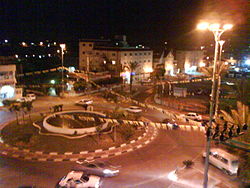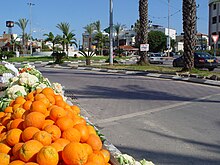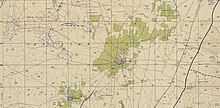| Revision as of 15:59, 1 September 2021 editNishidani (talk | contribs)Autopatrolled, Extended confirmed users99,556 editsNo edit summary← Previous edit | Revision as of 20:40, 1 September 2021 edit undoShadybabs (talk | contribs)Extended confirmed users879 edits remove POV pushingTags: Reverted Visual editNext edit → | ||
| Line 63: | Line 63: | ||
| During the 1948 Arab-Israeli war, the Israeli ] was ordered to "capture and destroy" Tira.<ref name=MorrisTira>{{cite book | author = Benny Morris | title = The birth of the Palestinian Refugee Problem Revisited | publisher = Cambridge University Press | year = 2004 | pages = 246,302,531}}</ref> However, the village was held by Iraqi troops and not captured. In May 1949, the village was transferred to Israeli sovereignty as part of the ] and the villagers were not expelled.<ref name=MorrisTira/> | During the 1948 Arab-Israeli war, the Israeli ] was ordered to "capture and destroy" Tira.<ref name=MorrisTira>{{cite book | author = Benny Morris | title = The birth of the Palestinian Refugee Problem Revisited | publisher = Cambridge University Press | year = 2004 | pages = 246,302,531}}</ref> However, the village was held by Iraqi troops and not captured. In May 1949, the village was transferred to Israeli sovereignty as part of the ] and the villagers were not expelled.<ref name=MorrisTira/> | ||
| In 1945, Tira's village lands extended over 26,803 ]s. Over the years 1953-1954, Israel expropriated a block of 5,232 dunams and, by 1962, of the original total, 8,599 dunams remained for village use.<ref>Jiryis,''The Arabs in Israel, 1976 p.292.</ref> The family-clan structure of its residents has not changed since then.<ref name="Kashua" >], ] 10 October 2013 .</ref> | |||
| Tira was defined as part of The Triangle and placed under a military governor. In the township, municipal elections are regarded as far more important than national elections, since the allocation of municipal jobs, the winners' spoils, depends on who wins control of the council.<ref name="Kashua" /> According to ], in 1956 the then governor had two members of the Tira local council banished in order to stop them from voting in the elections for a new chairman. He favoured the candidate proposed by ], the party the governor belonged to, and, once the 2 Arabs were banished, the governor's candidate managed to secure a majority.<ref>Sabri Jiryis ''The Arabs in Israel,'' 1976 p.248, n.9.</ref> | |||
| In the 1965 ] elections ] addressed 3,000 people in the village and stated that the official Israeli policy regarding the integration of its Arab citizens was going too far: integration was 'unnecessary' and would not take place.<ref>Sabri Jiryis, ''The Arabs in Israel,'' 1976 p.179</ref> In 1958 the ] movement was established by Israeli Arabs to press for equality between Israeli Arabs and Jews. The movement was banned in a decision by the Israeli Supreme Court, with judge ] declaring that it posed a threat to Israeli security. After its dissolution, Israel cracked down on Arab sports clubs, on the supposition that such associations were supported by al Ard, closing one in Taibeh. The Tira sports club resisted pressure by government officials to close down its own club's activities until late 1968, when the authorities ordered its closure when the ] declared it illegal on the grounds that one of the members was associated with ].<ref>Jiryis,''The Arabs in Israel,'' 1976 p.195.</ref> | |||
| ==Demographics== | ==Demographics== | ||
| Line 104: | Line 98: | ||
| == Crime== | == Crime== | ||
| Tira has been plagued by violent crime,<ref></ref> and organized crime is seen as the main driver. <ref></ref> Other factors leading to the crime wave include family feuds and organised gangs.<ref></ref> Violence in the name of protecting "honor" is also a problem.<ref></ref> | |||
| Tira's most famous son, ], recalls that when he was a child in the village, Tira was a quiet town, with a notable numbers of communists, very unlike the overcrowded, crime-ridden ghetto it later became.<ref name="Kashua" /><ref>Ruth Margalit, ]21 August 2015: 'Today, Tira is an overcrowded city, rife with corruption and gang violence. But when Kashua was growing up the streets were quiet and nameless. On airless summer nights, neighbors slept on their rooftops . .Like other people in the village, his father was active in the Communist Party; children grew up singing Red Army songs. Tira may be the only place on earth where you can meet a man named Abu Castro.'</ref> | |||
| ⚫ | According to the Israeli police, a contributor to problems policing towns such as Tira is inadequate co-operation from local population, whose fear and suspicion of the police makes them reluctant to report crime.<ref></ref> Calling for extra police to be assigned, Tira's leaders charge that police treat Arabs as second class citizens and don't properly investigate crime,<ref></ref> pointing to the fact that only 1 of 8 murders in Tira since 2020 has been solved, versus 71% percent of murders in Jewish communities.<ref></ref> | ||
| ⚫ | Between 2011 and 2019, Tira was the site of 31 homicides, the fifth highest per capita rate of all Arab towns in Israel. <ref>{{cite web|url=http://www.momken.org/Public/files/9YOB%20report%20english.pdf|title=Nine Years of Bloodshed|website=www.momken.org}}</ref> In response, a new police station was opened in Tira in 2013. Most Tira residents were opposed to this, but the Mayor overrode them. <ref></ref> | ||
| According to a native Arab Israeli resident of Tira, Nimer Sultany, now reader in law at ], Tira has a high crime and poverty rate, problems with education, employment, elements which the author attributes to the effects of decades of land confiscation.<ref name="Sultany" >Nimer Sultany, | According to a native Arab Israeli resident of Tira, Nimer Sultany, now reader in law at ], Tira has a high crime and poverty rate, problems with education, employment, elements which the author attributes to the effects of decades of land confiscation.<ref name="Sultany" >Nimer Sultany, | ||
| ] 18 May 2021:'Tira used to be an agricultural town. Decades of confiscation, home demolitions, incarceration, and discrimination in education, employment and welfare made my town, like virtually every Palestinian town in Israel, a ghetto with substandard schools and high rates of poverty and crime. |
] 18 May 2021:'Tira used to be an agricultural town. Decades of confiscation, home demolitions, incarceration, and discrimination in education, employment and welfare made my town, like virtually every Palestinian town in Israel, a ghetto with substandard schools and high rates of poverty and crime. | ||
| .'</ref> | |||
| ⚫ | |||
| According to the Israeli police, a contributor to problems policing towns such as Tira is inadequate co-operation from local population, who are reluctant to report crimes to the them.<ref name=Jpost>Ben Hartman, ] 1 May 2013.</ref> Fear of being murdered if one provides evidence of testimony to police is, according to Tira's mayor, one reason for this reluctance, added that a ] which Arab communities lacked, was required to address the issue.<ref name="Breiner" /> | |||
| ⚫ | Between 2011 and 2019, Tira was the site of 31 homicides.<ref>{{cite web|url=http://www.momken.org/Public/files/9YOB%20report%20english.pdf|title=Nine Years of Bloodshed|website=www.momken.org}}</ref> In response, a new police station was opened in Tira in 2013. |
||
| ==Sister cities== | ==Sister cities== | ||
Revision as of 20:40, 1 September 2021
For other uses, see Tira (disambiguation).| The neutrality of this article is disputed. Relevant discussion may be found on the talk page. Please do not remove this message until conditions to do so are met. (August 2021) (Learn how and when to remove this message) |
Tira
| |
|---|---|
| City | |
| Hebrew transcription(s) | |
| • ISO 259 | Ṭira |
| • Also spelled | Tire (official) |
 | |
 | |
 | |
| Coordinates: 32°13′56″N 34°56′54″E / 32.23222°N 34.94833°E / 32.23222; 34.94833 | |
| Grid position | 145/182 PAL |
| District | Central |
| Government | |
| • Mayor | Mamoun Abd al-Hay |
| Area | |
| • Total | 11,894 dunams (11.894 km or 4.592 sq mi) |
| Population | |
| • Total | 27,802 |
| • Density | 2,300/km (6,100/sq mi) |
| Name meaning | The High Land |

Tira (Template:Lang-ar al-Tira, Template:Lang-he), lit. "The Fort") is a city in the Central District of Israel. Part of The Triangle, a concentration of Arab towns and villages adjacent to the Green Line, Tira is close to Kfar Saba, and is well known by its neighbors for its weekly outdoor market, as well as for its Arab cuisine. In 2022 it had a population of 27,802.
History
In the 12th century, during the Crusader period, the village was owned by the Order of St. John. It was lease to Robert of Sinjil and his heirs. In the 14th and 15th century, Tira was a stop on the road between Gaza and Damascus, and a khan was constructed.
Ottoman era
Pierre Jacotin called the village Ertahah on his map from 1799.
In 1870, Victor Guérin found it to be a “village of seven hundred inhabitants, with gardens planted with fig trees and pomegranates, separated from each other by hedges of cactus.”
In 1882, the Palestine Exploration Fund's Survey of Western Palestine described Tira as: "A conspicuous village on a knoll in the plain, surrounded by olives, with a well on the west side."
British Mandate era
In the 1922 census of Palestine conducted by the British Mandate authorities, Tireh had a population of 1,588 inhabitants; 1,582 Muslims and 6 Orthodox Christians, increasing in the 1931 census to 2,192; 2,190 Muslims and 2 Christians, in a total of 380 houses.
In the 1945 statistics, Tira had 3,180 Muslim inhabitants, who owned a total of 26,803 dunams of land.


State of Israel
During the 1948 Arab-Israeli war, the Israeli Alexandroni Brigade was ordered to "capture and destroy" Tira. However, the village was held by Iraqi troops and not captured. In May 1949, the village was transferred to Israeli sovereignty as part of the Jordan-Israeli Armistice Agreement and the villagers were not expelled.
Demographics
According to CBS, in 2004 the ethnic makeup of the city was 99.9% Sunni Muslim Arab citizens of Israel (see also: Population groups in Israel).
A small number of Jews also live in Tira, mainly due to the cheaper housing costs offered by Tira than in many Jewish localities, such as nearby Kfar Saba.
According to CBS, in 2001 there were 9,600 males and 9,300 females. The population of the city was spread out, with 47.4% 19 years of age or younger, 16.2% between 20 and 29, 19.9% between 30 and 44, 10.8% from 45 to 59, 1.8% from 60 to 64, and 3.8% 65 years of age or older. The population growth rate in 2001 was 2.8%. In 2004, 41.3% of the population was 17 years or younger, 54.5% were between 18 and 64 years of age, and 4.2% were aged 65 and above.
Income
Tira is described as a prosperous Arab community. According to CBS, as of 2000, in the city there were 3,654 salaried workers and 953 are self-employed. The mean monthly wage in 2000 for a salaried worker in the city is ILS 3,767, a real change of 2.4% over the course of 2000. Salaried males have a mean monthly wage of ILS 4,494 (a real change of 6.1%) versus ILS 2,319 for females (a real change of −13.0%). The mean income for the self-employed is 4,289. There are 69 people who receive unemployment benefits and 1,183 people who receive an income guarantee. In 2004, 41.9% of the population was part of the workforce.
Education
According to CBS, there are 10 schools and 4,735 students in the city. There are seven elementary schools with 2,896 students, and three high schools with 1,839 students. Of 12th grade students, 64.8% were entitled to a matriculation certificate in 2001.
In 2004, 6.5% of the population had 0 years of education, 17.1% had up to 8 years, 55% had 9 to 12 years, 11.8% had 13–15 years, and 9.7% had 16 or more years of education. Ten percent had an academic degree.
The city's schools include:
- Al-Zahraa
- Al-Najah
- Al-G'azali
- Al-Majd
- Al-Aomareya
- Junior High A
- Junior High B
- Junior High c(g)
- Amal 1- Ibrahim Qsaem High School
- Technological High School
- Tira's Science High School
- Q School, focused on English language education
High school students from Tira have received scholarships from Israeli universities and participate in exchange programs such as Y.E.S (Bureau of Educational and Cultural Affairs), Seeds of Peace, and CISV.
Crime
Tira has been plagued by violent crime, and organized crime is seen as the main driver. Other factors leading to the crime wave include family feuds and organised gangs. Violence in the name of protecting "honor" is also a problem.
According to the Israeli police, a contributor to problems policing towns such as Tira is inadequate co-operation from local population, whose fear and suspicion of the police makes them reluctant to report crime. Calling for extra police to be assigned, Tira's leaders charge that police treat Arabs as second class citizens and don't properly investigate crime, pointing to the fact that only 1 of 8 murders in Tira since 2020 has been solved, versus 71% percent of murders in Jewish communities. Between 2011 and 2019, Tira was the site of 31 homicides, the fifth highest per capita rate of all Arab towns in Israel. In response, a new police station was opened in Tira in 2013. Most Tira residents were opposed to this, but the Mayor overrode them.
According to a native Arab Israeli resident of Tira, Nimer Sultany, now reader in law at SOAS, Tira has a high crime and poverty rate, problems with education, employment, elements which the author attributes to the effects of decades of land confiscation.
Sister cities
Tira is twinned with:
Notable residents
- Sayed Kashua, author and journalist
See also
References
- ^ "Regional Statistics". Israel Central Bureau of Statistics. Retrieved 21 March 2024.
- Palmer, 1881, p.194
- Petersen, 2001, p. 307, citing al-Zahri ed. Ravaisse, 199, Hartmann 1910, 689
- Petersen, 2001, p. 307, citing al-Umari ed. Shams al-Din
- Karmon, 1960, p. 170
- Guérin, 1875, p. 355
- Conder and Kitchener, 1882, SWP II, p. 166
- Barron, 1923, Table IX, Sub-district of Tulkarem, p. 28
- Barron, 1923, table XV, p. 48
- Mills, 1932, p. 58
- Government of Palestine, Department of Statistics, 1945, p. 22
- Government of Palestine, Department of Statistics. Village Statistics, April, 1945. Quoted in Hadawi, 1970 p.77
- ^ Benny Morris (2004). The birth of the Palestinian Refugee Problem Revisited. Cambridge University Press. pp. 246, 302, 531.
- , Ynet
- Israeli Arab porn sparks outrage
- Maverick educator seeks to change Israeli Arab world from within
- Two Arab men killed in separate violent incidents on first day of new year
- Woman, 38, shot dead in her beauty parlor in central city of Tira
- The murderous crime wave sweeping Israel's Arabs
- Israeli Arab porn sparks outrage
- Cautious optimism for new police station in Tira
- Arab citizens in Israel bemoan lack of policing
- Israel Police Solved 71 Percent of Murders in Jewish Community, but Only 23 Percent for Arabs
- "Nine Years of Bloodshed" (PDF). www.momken.org.
- Cautious optimism for new police station in Tira
- Nimer Sultany, 'Benjamin Netanyahu publicly assured the police not to worry about investigations and commissions of inquiry.' The Guardian 18 May 2021:'Tira used to be an agricultural town. Decades of confiscation, home demolitions, incarceration, and discrimination in education, employment and welfare made my town, like virtually every Palestinian town in Israel, a ghetto with substandard schools and high rates of poverty and crime. .'
- Sayed Kashua, 'Sayed Kashua: why I have to leave Israel ,', 20 July 2014. The Guardian.
Bibliography
- Barron, J.B., ed. (1923). Palestine: Report and General Abstracts of the Census of 1922. Government of Palestine.
- Conder, C.R.; Kitchener, H.H. (1882). The Survey of Western Palestine: Memoirs of the Topography, Orography, Hydrography, and Archaeology. Vol. 2. London: Committee of the Palestine Exploration Fund.
- Government of Palestine, Department of Statistics (1945). Village Statistics, April, 1945.
- Guérin, V. (1875). Description Géographique Historique et Archéologique de la Palestine (in French). Vol. 2: Samarie, pt. 2. Paris: L'Imprimerie Nationale.
- Hadawi, S. (1970). Village Statistics of 1945: A Classification of Land and Area ownership in Palestine. Palestine Liberation Organization Research Center.
- Hartmann, Richard (1910): Die Straße von Damaskus nach Kairo Zeitschrift der Deutschen Morgenländischen Gesellschaft, Bd. 64 (Cited in Petersen, 2001)
- Karmon, Y. (1960). "An Analysis of Jacotin's Map of Palestine" (PDF). Israel Exploration Journal. 10 (3, 4): 155–173, 244–253.
- Mills, E., ed. (1932). Census of Palestine 1931. Population of Villages, Towns and Administrative Areas. Jerusalem: Government of Palestine.
- Palmer, E.H. (1881). The Survey of Western Palestine: Arabic and English Name Lists Collected During the Survey by Lieutenants Conder and Kitchener, R. E. Transliterated and Explained by E.H. Palmer. Committee of the Palestine Exploration Fund.
- Petersen, Andrew (2001). A Gazetteer of Buildings in Muslim Palestine: (British Academy Monographs in Archaeology). Vol. I. Oxford University Press. ISBN 978-0-19-727011-0.
External links
- Official website (in Arabic)
- Welcome To Tira
- Survey of Western Palestine, Map 11: IAA, Wikimedia commons
- "2004 CBS Tira statistical survey" (PDF). (164 KiB) (in Hebrew)
| Central District of Israel | ||
|---|---|---|
| Cities |  | |
| Local councils | ||
| Regional councils | ||
| See also | ||
| Israeli cities | |
|---|---|
| 300,000+ | |
| 200,000–299,999 | |
| 100,000–199,999 | |
| 50,000–99,999 | |
| 15,000–49,999 |
|